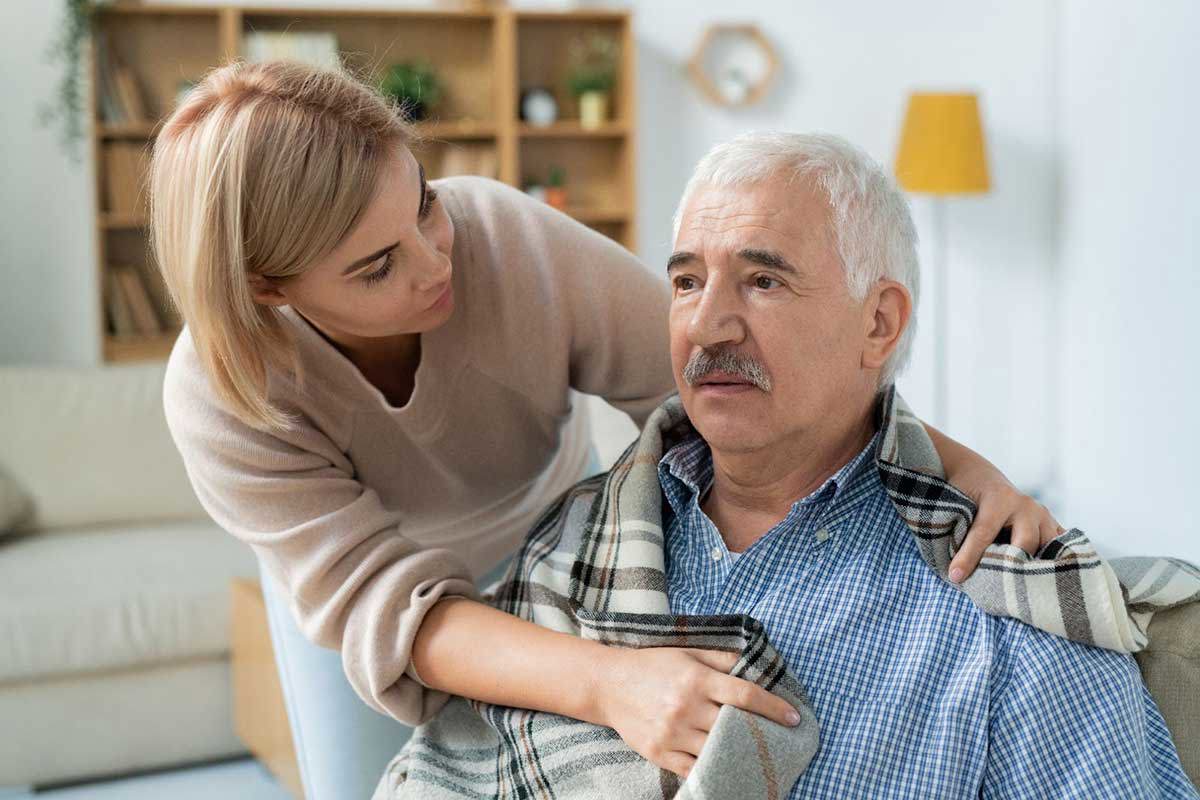Basal stimulation in care - promoting communication & well-being
Imagine you could give closeness without words, build trust and deeply touch someone's well-being - just through small, conscious touches and sensory experiences. This is exactly what basal stimulation makes possible. Find out how it works and why it can revolutionize care here.
In the care of people with severe perceptual or Communication Disorders - be it in dementia, after a stroke or in a vegetative state - basal stimulation is becoming an indispensable concept. It is not just about meeting physical needs, but above all about bringing the body and senses of those in need of care back into harmony and giving them the opportunity to interact with their environment.
This empathetic form of care not only promotes self-awareness and communication, but also helps to reduce anxiety and noticeably increase well-being.
In this article, you will learn everything you need to know about basal stimulation - from the goals and techniques to practical examples for use in everyday care. Whether you are a carer or a relative, you will receive useful instructions and tips to help you use this valuable method in a targeted way and enrich the lives of those in need of care.
When words fail and looks often remain empty, it is sometimes a gentle touch that opens doors. Basal stimulation is precisely this empathetic language of the senses - a way to reach people whose perception and communication are severely limited. It not only touches the skin, but also the soul and creates a connection that goes far beyond the visible.
Thomas, an elderly gentleman from Vienna, can barely speak after a stroke and is only vaguely aware of his surroundings. By gently touching his hands or making gentle movements, he senses that he is not alone. These small sensory experiences help him to feel in his own body again and slowly build a connection to the world around him - without words.
Definition of basal stimulation
Basal stimulation is a nursing method that specifically addresses the most basic senses: touch, movement, perception, smell, taste and hearing. Small, conscious stimuli are used to help bring the body back into balance, promote self-awareness and thus make communication possible without words.
It is particularly aimed at people with severe disabilities - such as after a stroke or with Dementia - and opens up new access points to the environment for them.
How did basal stimulation come about?
The idea of basal stimulation began in the 1970s with the German educationalist and social pedagogue Prof. Dr. Andreas Fröhlich. He observed how children with severe disabilities could be touched and reached through targeted sensory stimulation - despite their limited ability to communicate.
Inspired by his work, he developed basal stimulation as a holistic concept to help people of all ages experience their body and senses in a new way.
So people like Thomas or 10-year-old Marvin, who had hardly any contact with the outside world after a serious accident, can slowly begin to react again through gentle touches and targeted stimuli. A small smile or a relaxed sigh of relief are often the first signs of this return. Basal stimulation thus becomes a kind of bridge back to life when speech is silent.
Basal stimulation gives people, who often live quietly in their own world, a bridge back to feeling, sensing and experiencing. It focuses on three key objectives that enrich the lives of people in need of care like Thomas and Marvin in a special way.
"Basal stimulation can not only promote the self-awareness of those in need of care, but also create a deeper emotional connection between caregiver and patient."
Promoting self-awareness and communication
Thomas can barely feel his body moving - until his nurse gently takes his hand and strokes it gently. Suddenly a small window opens: Thomas becomes aware of himself again, feels his own heartbeat, the warmth of his touch. For Marvin's mother, who can barely exchange words with him after his serious accident, these small stimuli are a gateway to the world - Marvin's way of responding to them without speaking.
Reducing anxiety and promoting safety
For Thomas and Marvin, the silence can often be frightening. However, the familiar touches and calm impulses that his nurse and mother give him make their bodies feel safe and secure. In these moments, the worries subside, the tension eases and a feeling of calm and protection spreads - an anchor in the turmoil.
Increasing the quality of life for people in need of care
When Thomas' carer and Marvin's mother make these little sensory experiences possible, they give them more than just care: they give them moments of well-being that make joy and closeness tangible. Every smile, every breath shows how much life there is in these moments - even if words are missing..
Basal stimulation specifically addresses the senses that help us to perceive and interact with our environment. Especially for people like Thomas and Marvin, whose communication channels are limited, these sensory stimuli become important bridges to the world.
Tactile stimulation (touches)
Thomas' nurse gently strokes his hand and slowly runs it over his arm. This tactile stimulation, i.e. conscious touch, activates his sense of touch and helps him to consciously perceive his body again - an important step in strengthening his own perception.
Vestibular stimulation (balance)
Marvin's mother cradles him gently in her arms and moves him gently back and forth. These gentle movements, known as vestibular stimulation, his sense of balance is stimulated, which gives him security and improves his body awareness.
Vibrational stimulation
Thomas feels a gentle vibration on his back, which gently stimulates his nerve cells and promotes blood circulation. This vibratory stimulation in the form of impulses helps him to feel more alive and strengthen contact with his body.
Visual and auditory stimulation
Marvin hears his mother's calm voice as she shows him familiar objects. The combination of seeing and hearing awakens his attention and opens him up to his surroundings.
Olfactory and gustatory stimulation
Thomas perceives the familiar scent of an essential oil, which relaxes him and reminds him of beautiful moments in the past. Such sensory impressions are valuable anchors for him in his quiet world.
Whether for personal care, positioning or social interaction - basal stimulation is more than just a method. It is a valuable companion in everyday care that turns touch and movement into bridges.
Basal stimulation in personal hygiene
Daily body care offers numerous opportunities for conscious sensory stimulation. When Thomas' caregiver caresses his skin with gentle, warm hand movements, washing turns into a feel-good experience. Every touch becomes an invitation to feel your own body, even when words fail.
Marvin's mother uses these moments to soothe him with familiar scents and gentle massage strokes - turning the routine into a loving exchange full of security.
Positioning and positioning techniques
Careful positioning not only supports physical health, but also well-being. Marvin is gently turned and positioned in such a way that his senses are gently stimulated - lightly stroking his skin, calmly changing his position: small impulses that promote his perception.
In addition, his mother makes sure that his positioning is comfortable and secure and uses targeted changes of position to promote his sense of balance and prevent pressure sores.
Basal stimulation in quiet togetherness
Not only in active care situations - quiet moments can also be consciously designed. Thomas' carer regularly takes a few minutes to simply hold his hand, sit quietly with him or listen to music together. These mindful moments, free from demands, convey closeness and presence.
Marvin's mother also uses such times to read to him quietly or hold the familiar scent of his favourite pillow under his nose. Even if Marvin can't respond directly, an atmosphere of connection is created that works on a deep, sensual level.
Basal stimulation opens doors to a world in which words are often no longer enough. It gives people with-dementia, touch, support and connection after a stroke, in a vegetative state or in palliative care - especially when life is particularly fragile.
Application for dementia
For Dementia many people increasingly lose access to their environment. Basal stimulation offers them a language beyond words. Through gentle touch, familiar scents and calm sounds, the caregiver or the caregivers set an anchor that gives security and awakens memories.
Basal stimulation for stroke
Especially after a stroke, this form of stimulation can help to rebuild connections that were thought to be lost. Thomas' caregiver speaks in a calm voice, uses gentle touch and familiar objects to attract his attention and give him direction.
Support in a vegetative state
In a vegetative state, external stimuli are often greatly reduced and perception is restricted. Here, basal stimulation creates very gentle access to the world. Targeted touch and rhythmic movements stimulate the senses and make small reactions possible - a finger that moves slightly, a quiet exhalation.
Palliative care and quality of life
In palliative care, the focus is on quality of life - even when healing is no longer possible. Basal stimulation can relieve pain, alleviate anxiety and create a sense of well-being by addressing the body as a whole. Gentle touches, familiar scents and soothing sounds provide comfort and closeness.
Basal stimulation gives people in need of care more than just physical attention - it appeals to the senses, promotes self-awareness and creates emotional closeness. People with limited communication or mobility in particular experience greater participation, safety and quality of life as a result.
The most important advantages at a glance:
This effect often unfolds in small, quiet moments - and yet these are precisely the ones that are most important in the Everyday care make the difference.
Basal stimulation can also be a valuable bridge in your own four walls - towards more closeness, safety and enjoyment of life. For relatives in particular, this means: no complicated hand movements, but mindful everyday gestures that make a tangible connection. It's the little things that make a big difference - a warm hand on the shoulder, a familiar scent, a quiet moment together.
Simple exercises for home
You don't need any special equipment to implement basal stimulation in everyday life. Many stimuli can be lovingly incorporated into daily routines:
- Gentle touches: Take the time to hold your hand, stroke your arm or touch your skin calmly and evenly when applying cream.
- Using familiar scents: A few drops of your favorite scent on a scarf or pillow can awaken memories and provide guidance.
- Music and voices: Play soft, familiar music or speak in a calm tone of voice - even if there is no response, your voice will be heard.
- Allow movement: Slightly rocking on a chair, slowly changing position in bed or gently raising your arms - all of these activate the body.
- Creating fixed rituals: Repetitions provide security. For example, the same song in the morning or a familiar greeting .
Marvin's mother has learned that it is often the quiet minutes after waking up when a gentle touch on the forehead or the scent of his favorite pillow are worth a thousand words.
How caregivers and relatives can work together
Basal stimulation thrives on trust - and on cooperation. The closer relatives and carers work together, the better this method can work. Carers have the specialist knowledge and experience, while relatives have a deep understanding of their loved one's needs.
- Watching together: What is good for you? What triggers restlessness? Regular exchange helps to use stimuli in a targeted manner.
- Make arrangements: Who adopts which rituals? Are there certain times of day for stimuli?
- Learning from each other: Caregivers can show simple gestures - and relatives report favorite songs, preferences or small reactions.
- Building trust: When everyone pulls together, the person in need of care feels it too - and feels secure.
Thomas' nurse regularly takes time to talk to his daughter. Together, they have developed rituals that calm him down: a gentle hand massage in the evening, soft music when lying down. This connection between care and family makes basal stimulation a real journey of the heart.
With sound knowledge and targeted training, you can use basal stimulation safely and effectively in care settings. Here you will find valuable starting points and recommended literature.
Certified training opportunities
- Basic and advanced courses: Der Internationale Förderverein Basale Stimulation e.V. offers certified basic courses as well as advanced courses that combine practical exercises and reflection. At basale.at there is also a basic course with internationally recognized certification as well as an advanced course.
- Further education:For nurses, there are targeted certificate courses for further specialist training - ideal if you have already completed basic and advanced courses and would like to go into more depth.
- Palliative Care:Specialized courses such as "Basal Stimulation® in Palliative Care and Hospice Work" (e.g. at DAA mbH) convey the basics of palliative care. e.g. at DAA mbH) teach you how to provide closeness, relaxation and dignity at the end of life.
- Course on the ÖGKV Styria: "Holistic promotion of perception in stroke patients through basal stimulation" - specially tailored to post-stroke care.
On kursfinder.de, for example, you can find more courses on basal stimulation.
Book recommendations
Some standard works give you practical and theoretical impulses:
- Basal Stimulation® in Nursing - The basics by Christel Bienstein & Andreas Fröhlich - comprehensive, with many exercises
- Basal Stimulation® in the care of the elderly -practical methods especially for older people
- Basal Stimulation (Nydahl et al.) -a classic with experience reports for intensive care & children - clear and well-founded
Basal stimulation is much more than a care intervention - it is a key to reconnecting people with themselves and their environment. Whether you work as a carer or are involved as a relative, with targeted sensory stimulation you can not only promote self-awareness and communication, but also build a deep emotional connection that creates trust, safety and security.
The techniques and examples in this article show you how easy it can be to take your first steps - be it through conscious touch, familiar sounds or pleasant scents. You don't need elaborate equipment, but above all mindfulness and the willingness to meet people with all your senses.
Never forget: It's not just about care - it's about humanity, dignity and quality of life. With every small gesture, you make an important contribution to more closeness and joie de vivre in the everyday lives of those in need of care. Take the impulses with you, try out what feels right and keep at it - because every moment that you consciously shape makes a difference.
Register now at noracares and find a caregiver, who masters basal stimulation - for personalized advice and compassionate care that connects.










